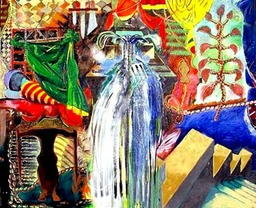Information for Struts Gallery
OSTINATO at
is a feature-length, 93 minute video made of hundreds of my paintings, prints, and drawings edited together in rhythmic patterns of one-tenth of a second each. This means there are ten images each second, 600 each minute, some 55,800 glimpses in all. It’s a painting-mosaic in motion. The images were hand-set into their patterns on a rudimentary video-editing program. It has an original music score composed by Art Damage, AKA Matthew Claener, whose work can be found on Bandcamp.
The long video, and its accompanying variations, are meant to be projected at any size on any surface, walls, ceiling, floor. The multi-screen piece can be architecturally immersive, or focussed, depending on the room’s scale and ambience, and on available projection equipment. The film’s aspect ratio often changes with the shape of the painting, and comments on the support surface. The experience can be maintained on a loop for any length of time.
You might expect a piece like this to be perceptually unmanageable, and the images do pass by faster than the brain is able to grasp the gestalt of any given impression. But this allows the eye and brain to engage in a second-order viewing in which the watcher becomes free to impose a narrative onto the rich visual compost offered. It’s not unlike watching fire, or rushing water, or falling snow.
The film is curiously watchable in the traditional sense, not aggressively disorienting but strangely exciting and soothing at the same time. Our visual habits have quickened along with the speed of contemporary media. One-tenth of a second cuts are common in even broadcast TV ads. In fact, the teasing aspect of the ultra-fleet peek seems to have become a staple exploitive device in the attention economy. It’s not a one-way imposition, however. Our perceptual apparatus thrives on challenge. This century has proved attention-evolution in action. Generation Alphas have no trouble with perceptual velocity, including this video.
The original ‘Ostinato’ video now has several remix variants (made with higher tech software) which reflect and contradict one another. Samples can be seen here:
and here:
Physically they live on small solid-state portable hard drives. Its flashing-images risk is low —hundreds of people have seen it as a one-channel projection with no problem— but requires a warning nonetheless. Compared to the lighting effects at a typical EDM concert, which are programmed for surprise and awe, OSTINATO’s flow is anti-anxiety. It’s more like studying the details of Gothic or Baroque architecture.
The protean flow of images replicates the act of painting when you are in the flow state, in which you allow the art to be a little smarter than the artist. In contemporary painting a picture’s logic leads to the point where a large structural gamble is demanded, which could ruin everything, or lead to a resolution that couldn’t be imagined beforehand. Process over procedure.
The video-mosaic method has become an extremely helpful augmentation to my painting life. Long ago I used to dream often of moving paintings, and wake up saddened that it couldn’t really be. But after the digital world arrived, which started for me in 1994, the picture-comes-to-life became a new tool. It fulfilled Cocteau’s remark in the 1930s that when the apparatus of the cinema became as affordable as paper and pencil, then a new form could be achieved. All my work now doubles as grist for the mill of this quasi-animation method.
‘Ostinato’ is an open-ended perceptual exercise-adventure in vision.
Vision is ‘just seeing’. As a deliberate activity it’s very much in the back seat of daily life. Children can see– they have a much wider range of visual awareness – because their eyes haven’t been over-tutored by laws of perspective or compositional logic.
Everyday open-eye vision is what we are directly conscious of, but there’s much more going on that we ignore. Seeing includes open-eye, peripheral and hypnagogic (closed-eye) vision, along with moving visual thinking, dream vision and memory feedback – in short, whatever affects the eyes, the brain and the nervous system. All these have a right to be called seeing since they enable us to inherit the full spectrum of our optic and nervous systems.
‘Ostinato’ is predisposed to embody these various experiences of seeing, because it is an open-ended perceptual environment which lasts as long as one wishes. It’s too fast to conceptualize but too much fun to reject. It urges one not to shut off the brain for passive entertainment, but rather to indulge the brain in sensory uncertainty, as with dreams.
Hypnagogic vision is what you see with your eyes closed – at first a field of shifting, multi-coloured movements that gradually assume various shapes. It’s optic feedback: the nervous system seems to project what you have previously experienced – your visual memories – into the optic nerve endings. lt’s also called closed-eye vision. Moving visual thinking, on the other hand, occurs deeper in the synapsing of the brain. It’s a streaming of shapes that are not nameable – a vast visual ‘song’ of the cells expressing their internal life. Peripheral vision is what you don’t pay close attention to during the day and which surfaces at night in your dreams. And memory feedback consists of the editings of your remembrance. It’s like a highly edited movie made from the real.
These ideas provide the engine for the experience of being in the centre of this kind of sensory flow projected as a 'sensurround' experience. It's a gymnasium for the sensorium.
This video-mosaic method is easy to learn and easy to teach, if demanding to actually do. It lends itself to many experiments. For example: you can photograph the walls of an empty gallery and then animate the footage to rollover motion, resizing of aspect ratio, applied effects, sound design, and any number of visual interventions, then project the result on those same gallery walls to uncanny effect.













No comments:
Post a Comment